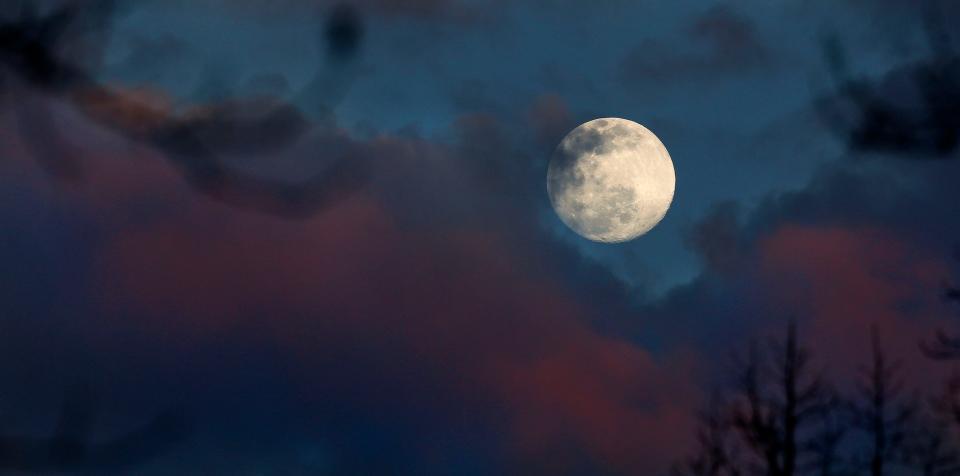June's full moon, the Strawberry Moon, could be big and colorful this year. Here's why
June's full moon, the Strawberry Moon, will take to the skies on Friday, and it's expected to be a big and colorful piece of shortcake.
USA TODAY reports that the full moon will be unusually low in the sky, making it appear larger. Since the Strawberry Moon is happening the day after the summer solstice, when the sun is at its most northerly point in the sky for the year, the full moon will occur at its lowest point. And because the full moon will be so low, it will appear to be huge, an effect known as the "Moon Illusion."
Also, because it happens just after the summer solstice, the moon could have a golden color, astronomers tell the publication.
Why is the moon orange tonight?
The strawberry moon is colorful because it takes a low path across the sky, Bob Bonadurer, director of the Milwaukee Public Museum's planetarium, told USA TODAY. That low arc of the full moon means moonlight must travel through more of the Earth's atmosphere, giving the moon an orange or yellow glow.
When is the full moon in June 2024?
The full moon will be at its brightest at 9:08 p.m. June 21. However, the moon will still appear to be full to the casual viewer the night before and after, according to Space.com.
Why is June's full moon called the Strawberry Moon?
According to the Farmer's Almanac, the Strawberry Moon came from a variety of sources, including American Indian tribes honoring the fruit that ripens around this time of the year.
Other names for this month's full moon include “The Moon When the Buffalo Bellows” from the Arapaho of the Great Plains and the "Honey Moon" in Anglo-Saxon traditions.

What's the best time to view the Strawberry Moon in Ohio?
According to the Farmer's Almanac, the full moon will rise over Akron at 9:22 p.m. June 21, over Columbus at 9:23 p.m., and at 9:26 p.m. over Cincinnati. With the full moon's peak happening at 9:08 p.m., get out at moonrise to get the brightest view.
When is the full moon in July 2024?
The Buck Moon will rise on Sunday, July 21, 2024, according to the Farmer's Almanac.
Full moon 2024 calendar
Here is the remaining full moon calendar for 2024:
June 21: Strawberry Moon
July 21: Buck Moon
Aug. 19: Sturgeon Moon
Sept. 17: Harvest Moon
Oct. 17: Hunter's Moon
Nov. 15: Beaver Moon
Dec. 15: Cold Moon
What's in a name? What to know about full moons in 2024: When full moons are and their names

What is a monthly blue moon?
There are two types of blue moons — monthly and seasonal, according to NASA.
A monthly blue moon is the second full moon of a calendar month with two full moons. The next monthly blue moon will happen on May 31, 2026, according to Time and Date.
What is a seasonal blue moon?
A seasonal blue moon, according to NASA, is the third full moon of an astronomical season that has four full moons. The next one will be Aug. 19, 2024, according to Time and Date.
So, what's an astronomical season? It's the period of time between solstices and equinoxes, according to NASA. For example, it's said spring begins on the spring equinox -- when the Northern and Southern hemispheres have roughly the same amount of daylight -- and lasts until summer begins on the summer solstice -- the longest day of the year. That period of time is one astronomical season.
Each season typically has three full moons, each about 30 days apart. But because the lunar cycle and the calendar don't match, occasionally there will be a fourth full moon during that period of time.
What is a supermoon?
A supermoon occurs when the moon's orbit brings it closest to the earth at the same time as a full moon, according to NASA.
According to Space.com, there will be four supermoons in 2024: on Aug. 19, Sept. 17, Oct. 17 and Nov. 15.
What is a blood moon?
A blood moon happens during a total lunar eclipse, according to Space.com, when the moon takes on a reddish hue.
The last total lunar eclipse occurred on Nov. 8, 2022, during the beaver moon. The next one won't happen until March 2025.
Blood moons occur when the moon is fully in the shadow of the Earth. However, a bit of light reflected off the Earth hits the moon's surface, making it appear red.
This article originally appeared on Record-Courier: Full moon June 2024: How to see the Strawberry moon in Ohio

